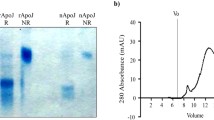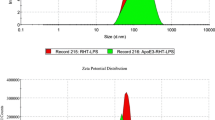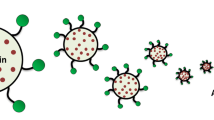Abstract
Accumulation of extracellular β-amyloid (Aβ) is crucial for the pathogenesis of Alzheimer’s disease (AD), and the development of novel therapeutic agents that can both accelerate Aβ clearance and inhibit the subsequent pathological cascades is regarded as a promising strategy for AD management. In our previous study, we have constructed discoidal apolipoprotein E3–reconstituted high-density lipoprotein (ApoE3-rHDL) as an efficient nanoplatform that can penetrate the blood–brain barrier and accelerate Aβ clearance for a combination treatment of AD. To further improve its drug loading capacity, we hypothesized that spherical rHDL might serve as a more powerful nanocarrier if it has the same brain delivery and Aβ clearance abilities as the discoidal rHDL does. To evaluate the potential of spherical rHDL as a promising alternative for the combination therapy for AD, here, we investigated the effect of the shape of rHDL on its brain delivery, Aβ clearance, and anti-AD efficacy. We found that spherical rHDL had stronger Aβ-binding affinity than discoidal rHDL did, more effectively facilitated microglial uptake and degradation of Aβ1–42, achieved better brain distribution after intravenous administration, and more powerfully reduced Aβ deposition, decreased microglia activation, attenuated neurological damage, and rescued memory deficits in a mouse model of AD. Among the rHDLs evaluated, monosialotetrahexosyl ganglioside–incorporated spherical rHDL exerted the best effect. The findings of this study for the first time show a shape effect of an rHDL nanocarrier on its biological functions and suggest that a spherical lipoprotein-mimic nanocarrier may serve as a more efficient multifunctional nanoplatform for AD therapy.
Similar content being viewed by others
References
Kuai, R.; Li, D.; Chen, Y. E.; Moon, J. J.; Schwendeman, A. High-density lipoproteins: Nature’s multifunctional nanoparticles. ACS Nano 2016, 10, 3015–3041.
Mo, Z. C.; Ren, K.; Liu, X.; Tang, Z. L.; Yi, G. H. A high-density lipoprotein-mediated drug delivery system. Adv. Drug Deliv. Rev. 2016, 106, 132–147.
Damiano, M. G.; Mutharasan, R. K.; Tripathy, S.; McMahon, K. M.; Thaxton, C. S. Templated high density lipoprotein nanoparticles as potential therapies and for molecular delivery. Adv. Drug Deliv. Rev. 2013, 65, 649–662.
Bricarello, D. A.; Smilowitz, J. T.; Zivkovic, A. M.; German, J. B.; Parikh, A. N. Reconstituted lipoprotein: A versatile class of biologically-inspired nanostructures. ACS Nano 2011, 5, 42–57.
Thaxton, C. S.; Rink, J. S.; Naha, P. C.; Cormode, D. P. Lipoproteins and lipoprotein mimetics for imaging and drug delivery. Adv. Drug Deliv. Rev. 2016, 106, 116–131.
Simonsen, J. B. Evaluation of reconstituted high-density lipoprotein (rHDL) as a drug delivery platform-a detailed survey of rHDL particles ranging from biophysical properties to clinical implications. Nanomedicine 2016, 12, 2161–2179.
Huang, H.; Cruz, W.; Chen, J.; Zheng, G. Learning from biology: Synthetic lipoproteins for drug delivery. Wiley Interdiscip. Rev.: Nanomed. Nanobiotechnol. 2015, 7, 298–314.
Zhang, W. L.; He, H. L.; Liu, J. P.; Wang, J.; Zhang, S. Y.; Zhang, S. S.; Wu, Z. M. Pharmacokinetics and atherosclerotic lesions targeting effects of tanshinone II–A discoidal and spherical biomimetic high density lipoproteins. Biomaterials 2013, 34, 306–319.
Zhang, W. L.; Xiao, Y.; Liu, J. P.; Wu, Z. M.; Gu, X.; Xu, Y. M.; Lu, H. Structure and remodeling behavior of drugloaded high density lipoproteins and their atherosclerotic plaque targeting mechanism in foam cell model. Int. J. Pharm. 2011, 419, 314–321.
Hebert, L. E.; Weuve, J.; Scherr, P. A.; Evans, D. A. Alzheimer disease in the United States (2010–2050) estimated using the 2010 census. Neurology 2013, 80, 1778–1783.
Wang, J.; Gu, B. J.; Masters, C. L.; Wang, Y. J. A systemic view of Alzheimer disease-insights from amyloid-β metabolism beyond the brain. Nat. Rev. Neurol. 2017, 13, 612–623.
Kurochkin, I. V.; Guarnera, E.; Berezovsky, I. N. Insulindegrading enzyme in the fight against Alzheimer’s disease. Trends Pharmacol. Sci. 2018, 39, 49–58.
Villemagne, V. L.; Doré, V.; Burnham, S. C.; Masters, C. L.; Rowe, C. C. Imaging tau and amyloid-β proteinopathies in Alzheimer disease and other conditions. Nat. Rev. Neurol. 2018, 14, 225–236.
Lee, S. J. C.; Nam, E.; Lee, H. J.; Savelieff, M. G.; Lim, M. H. Towards an understanding of amyloid-β oligomers: Characterization, toxicity mechanisms, and inhibitors. Chem. Soc. Rev. 2017, 46, 310–323.
Hyman, B. T. Amyloid-dependent and amyloid-independent stages of Alzheimer disease. Arch. Neurol. 2011, 68, 1062–1064.
Heneka, M. T.; Golenbock, D. T.; Latz, E. Innate immunity in Alzheimer’s disease. Nat. Immunol. 2015, 16, 229–236.
Reiss, A. B.; Arain, H. A.; Stecker, M. M.; Siegart, N. M.; Kasselman, L. J. Amyloid toxicity in Alzheimer’s disease. Rev. Neurosci., in press, DOI: 10.1515/revneuro-2017-0063.
Sevigny, J.; Chiao, P.; Bussière, T.; Weinreb, P. H.; Williams, L.; Maier, M.; Dunstan, R.; Salloway, S.; Chen, T.; Ling, Y. et al. The antibody aducanumab reduces Aβ plaques in Alzheimer’s disease. Nature 2016, 537, 50–56.
Song, Q. X.; Huang, M.; Yao, L.; Wang, X. L.; Gu, X.; Chen, J.; Chen, J.; Huang, J. L.; Hu, Q. Y.; Kang, T. et al. Lipoprotein-based nanoparticles rescue the memory loss of mice with Alzheimer’s disease by accelerating the clearance of amyloid-beta. ACS Nano 2014, 8, 2345–2359.
Song, Q. X.; Song, H. H.; Xu, J. R.; Huang, J. L.; Hu, M.; Gu, X.; Chen, J.; Zheng, G.; Chen, H. Z.; Gao, X. L. Biomimetic ApoE-reconstituted high density lipoprotein nanocarrier for blood-brain barrier penetration and amyloid beta-targeting drug delivery. Mol. Pharm. 2016, 13, 3976–3987.
Huang, M.; Hu, M.; Song, Q. X.; Song, H. H.; Huang, J. L.; Gu, X.; Wang, X. L.; Chen, J.; Kang, T.; Feng, X. Y. et al. GM1-modified lipoprotein-like nanoparticle: Multifunctional nanoplatform for the combination therapy of Alzheimer’s disease. ACS Nano 2015, 9, 10801–10816.
Huang, J. L.; Jiang, G.; Song, Q. X.; Gu, X.; Hu, M.; Wang, X. L.; Song, H. H.; Chen, L. P.; Lin, Y. Y.; Jiang, D. et al. Lipoprotein-biomimetic nanostructure enables efficient targeting delivery of siRNA to Ras-activated glioblastoma cells via macropinocytosis. Nat. Commun. 2017, 8, 15144.
Schwendeman, A.; Sviridov, D. O.; Yuan, W. M.; Guo, Y. H.; Morin, E. E.; Yuan, Y.; Stonik, J.; Freeman, L.; Ossoli, A.; Thacker, S. et al. The effect of phospholipid composition of reconstituted HDL on its cholesterol efflux and anti-inflammatory properties. J. Lipid Res. 2015, 56, 1727–1737.
Gentile, F.; Chiappini, C.; Fine, D.; Bhavane, R. C.; Peluccio, M. S.; Cheng, M. M. C.; Liu, X.; Ferrari, M.; Decuzzi, P. The effect of shape on the margination dynamics of non-neutrally buoyant particles in two-dimensional shear flows. J. Biomech. 2008, 41, 2312–2318.
Molino, Y.; David, M.; Varini, K.; Jabès, F.; Gaudin, N.; Fortoul, A.; Bakloul, K.; Masse, M.; Bernard, A.; Drobecq, L. et al. Use of LDL receptor-targeting peptide vectors for in vitro and in vivo cargo transport across the blood-brain barrier. FASEB J. 2017, 31, 1807–1827.
Basak, J. M.; Verghese, P. B.; Yoon, H.; Kim, J.; Holtzman, D. M. Low-density lipoprotein receptor represents an apolipoprotein E-independent pathway of Aβ uptake and degradation by astrocytes. J. Biol. Chem. 2012, 287, 13959–13971.
Wang, D. R.; El-Amouri, S. S.; Dai, M.; Kuan, C. Y.; Hui, D. Y.; Brady, R. O.; Pan, D. Engineering a lysosomal enzyme with a derivative of receptor-binding domain of apoE enables delivery across the blood-brain barrier. Proc. Natl. Acad. Sci. USA 2013, 110, 2999–3004.
Prévost, M.; Raussens, V. Apolipoprotein E-low density lipoprotein receptor binding: Study of protein-protein interaction in rationally selected docked complexes. Proteins 2004, 55, 874–884.
Rajora, M. A.; Ding, L.; Valic, M.; Jiang, W.; Overchuk, M.; Chen, J.; Zheng, G. Tailored theranostic apolipoprotein E3 porphyrin-lipid nanoparticles target glioblastoma. Chem. Sci. 2017, 8, 5371–5384.
Stine, W. B., Jr.; Dahlgren, K. N.; Krafft, G. A.; La Du, M. J. In vitro characterization of conditions for amyloid-β peptide oligomerization and fibrillogenesis. J. Biol. Chem. 2003, 278, 11612–11622.
Robert, J.; Stukas, S.; Button, E.; Cheng, W. H.; Lee, M.; Fan, J. J.; Wilkinson, A.; Kulic, I.; Wright, S. D.; Wellington, C. L. Reconstituted high-density lipoproteins acutely reduce soluble brain Aβ levels in symptomatic APP/PS1 mice. Biochim. Biophys. Acta 2016, 1862, 1027–1036.
Chiu, I. M.; Phatnani, H.; Kuligowski, M.; Tapia, J. C.; Carrasco, M. A.; Zhang, M.; Maniatis, T.; Carroll, M. C. Activation of innate and humoral immunity in the peripheral nervous system of ALS transgenic mice. Proc. Natl. Acad. Sci. USA 2009, 106, 20960–20965.
Yao, L.; Gu, X.; Song, Q. X.; Wang, X. L.; Huang, M.; Hu, M.; Hou, L. N.; Kang, T.; Chen, J.; Chen, H. Z. et al. Nanoformulated alpha-mangostin ameliorates Alzheimer’s disease neuropathology by elevating LDLR expression and accelerating amyloid-beta clearance. J. Control. Release 2016, 226, 1–14.
Portioli, C.; Bovi, M.; Benati, D.; Donini, M.; Perduca, M.; Romeo, A.; Dusi, S.; Monaco, H. L.; Bentivoglio, M. Novel functionalization strategies of polymeric nanoparticles as carriers for brain medications. J. Biomed. Mater. Res. A 2017, 105, 847–858.
Ćurić, A.; Möschwitzer, J. P.; Fricker, G. Development and characterization of novel highly-loaded itraconazole poly(butyl cyanoacrylate) polymeric nanoparticles. Eur. J. Pharm. Biopharm. 2017, 114, 175–185.
Calabuig-Navarro, M. V.; Jackson, K. G.; Kemp, C. F.; Leake, D. S.; Walden, C. M.; Lovegrove, J. A.; Minihane, A. M. A randomized trial and novel SPR technique identifies altered lipoprotein-LDL receptor binding as a mechanism underlying elevated LDL-cholesterol in APOE4s. Sci. Rep. 2017, 7, 44119.
Tassa, C.; Duffner, J. L.; Lewis, T. A.; Weissleder, R.; Schreiber, S. L.; Koehler, A. N.; Shaw, S. Y. Binding affinity and kinetic analysis of targeted small molecule-modified nanoparticles. Bioconjug. Chem. 2010, 21, 14–19.
Yin, T. T.; Yang, L. C.; Liu, Y.; Zhou, X. B.; Sun, J.; Liu, J. Sialic acid (SA)-modified selenium nanoparticles coated with a high blood-brain barrier permeability peptide-B6 peptide for potential use in Alzheimer’s disease. Acta Biomater. 2015, 25, 172–183.
Li, Y.; Kröger, M.; Liu, W. K. Shape effect in cellular uptake of PEGylated nanoparticles: Comparison between sphere, rod, cube and disk. Nanoscale 2015, 7, 16631–16646.
Goedert, M. NEURODEGENERATION. Alzheimer’s and Parkinson’s diseases: The prion concept in relation to assembled Aβ, tau, and α-synuclein. Science 2015, 349, 1255555.
Goldstein, L. E.; Muffat, J. A.; Cherny, R. A.; Moir, R. D.; Ericsson, M. H.; Huang, X. D.; Mavros, C.; Coccia, J. A.; Faget, K. Y.; Fitch, K. A. et al. Cytosolic β-amyloid deposition and supranuclear cataracts in lenses from people with Alzheimer’s disease. Lancet 2003, 361, 1258–1265.
Jarrett, J. T.; Lansbury, P. T., Jr. Seeding “one-dimensional crystallization” of amyloid: A pathogenic mechanism in Alzheimer’s disease and scrapie? Cell 1993, 73, 1055–1058.
Colvin, M. T.; Silvers, R.; Ni, Q. Z.; Can, T. V.; Sergeyev, I.; Rosay, M.; Donovan, K. J.; Michael, B.; Wall, J.; Linse, S. et al. Atomic resolution structure of monomorphic Aβ42 amyloid fibrils. J. Am. Chem. Soc. 2016, 138, 9663–9674.
He, Z. H.; Guo, J. L.; McBride, J. D.; Narasimhan, S.; Kim, H.; Changolkar, L.; Zhang, B.; Gathagan, R. J.; Yue, C. Y.; Dengler, C. et al. Amyloid-β plaques enhance Alzheimer’s brain tau-seeded pathologies by facilitating neuritic plaque tau aggregation. Nat. Med. 2018, 24, 29–38.
Dahlgren, K. N.; Manelli, A. M.; Stine, W.B., Jr.; Baker, L. K.; Krafft, G. A.; LaDu, M. J. Oligomeric and fibrillar species of amyloid-β peptides differentially affect neuronal viability. J. Biol. Chem. 2002, 277, 32046–32053.
Jan, A.; Gokce, O.; Luthi-Carter, R.; Lashuel, H. A. The ratio of monomeric to aggregated forms of Abeta40 and Abeta42 is an important determinant of amyloid-beta aggregation, fibrillogenesis, and toxicity. J. Biol. Chem. 2008, 283, 28176–28189.
Colvin, M. T.; Silvers, R.; Frohm, B.; Su, Y. C.; Linse, S.; Griffin, R. G. High resolution structural characterization of Aβ42 amyloid fibrils by magic angle spinning NMR. J. Am. Chem. Soc. 2015, 137, 7509–7518.
Yu, J. T.; Tan, L.; Hardy, J. Apolipoprotein E in Alzheimer’s disease: An update. Annu. Rev. Neurosci. 2014, 37, 79–100.
Tokuda, T.; Calero, M.; Matsubara, E.; Vidal, R.; Kumar, A.; Permanne, B.; Zlokovic, B.; Smith, J. D.; Ladu, M. J.; Rostagno, A. et al. Lipidation of apolipoprotein E influences its isoform-specific interaction with Alzheimer’s amyloid beta peptides. Biochem. J. 2000, 348, 359–365.
Kurz, A.; Perneczky, R. Amyloid clearance as a treatment target against Alzheimer’s disease. J. Alzheimers Dis. 2011, 24, 61–73.
Feng, C. Z.; Yin, J. B.; Yang, J. J.; Cao, L. Regulatory factor X1 depresses ApoE-dependent Aβ uptake by miRNA-124 in microglial response to oxidative stress. Neuroscience 2017, 344, 217–228.
Li, M.; Yang, X. J.; Ren, J. S.; Qu, K. G.; Qu, X. G. Using graphene oxide high near-infrared absorbance for photothermal treatment of Alzheimer’s disease. Adv. Mater. 2012, 24, 1722–1728.
Guan, Y. J.; Li, M.; Dong, K.; Gao, N.; Ren, J. S.; Zheng, Y. C.; Qu, X. G. Ceria/POMs hybrid nanoparticles as a mimicking metallopeptidase for treatment of neurotoxicity of amyloid-β peptide. Biomaterials 2016, 98, 92–102.
Butterfield, D. A.; Poon, H. F. The senescence-accelerated prone mouse (SAMP8): A model of age-related cognitive decline with relevance to alterations of the gene expression and protein abnormalities in Alzheimer’s disease. Exp. Gerontol. 2005, 40, 774–783.
Akiguchi, I.; Pallàs, M.; Budka, H.; Akiyama, H.; Ueno, M.; Han, J. X.; Yagi, H.; Nishikawa, T.; Chiba, Y.; Sugiyama, H. et al. SAMP8 mice as a neuropathological model of accelerated brain aging and dementia: Toshio Takeda’s legacy and future directions. Neuropathology 2017, 37, 293–305.
Acknowledgements
This work was supported by the National Natural Science Foundation of China (Nos. 81373351, 81573382, 81722043, and 81503174), the National Science and Technology Major Project (No. 2018ZX09734005-007), the National Youth Talent Support Program, grant from Shanghai Science and Technology Committee (No. 15540723700), and “Shu Guang” project supported by Shanghai Municipal Education Commission and Shanghai Education Development Foundation (No. 15SG14).
Author information
Authors and Affiliations
Corresponding authors
Rights and permissions
About this article
Cite this article
Song, H., Ma, X., Xu, J. et al. The shape effect of reconstituted high-density lipoprotein nanocarriers on brain delivery and Aβ clearance. Nano Res. 11, 5615–5628 (2018). https://doi.org/10.1007/s12274-018-2107-8
Received:
Revised:
Accepted:
Published:
Issue Date:
DOI: https://doi.org/10.1007/s12274-018-2107-8




